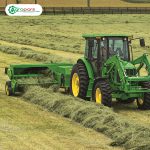Introduction to Agricultural Rotivators
Agricultural rotivators are essential tillage tools that prepare the soil bed for the next operation, whether it is cultivation or irrigation.
What Are Agricultural Rotivators?
Agricultural rotary tillers, also known as rototillers or power tillers, help farmers prepare the soil for cultivation by creating an ideal seedbed free of weeds. This method is considered secondary tillage and is used to break up hard soil layers and mix weeds into the soil.
Whenever we use rototillers or power tillers, we must consider both their advantages and disadvantages.
Advantages of Rotary Tillers
Rototillers operate at a shallow depth (maximum 20 cm) and work at relatively high speeds. Some key benefits of using rotary tillers include:
-
Breaking Clods & Leveling Soil: Creates a flat and smooth seedbed.
-
Improved Soil Aeration: Enhances air circulation in the soil, promoting root growth.
-
Increased Water Absorption: Helps soil retain more moisture, benefiting crops.
-
Weed Control: Effectively manages weed growth by mixing them into the soil.
-
High Efficiency: Operates at high speeds, improving farm productivity.
Disadvantages of Rotary Tillers
Despite their benefits, rotary tillers also have some drawbacks, which can limit their use, especially in sandy soils:
-
Soil Structure Disintegration: Repeated use can disrupt the physical structure of the soil.
-
Damage to Soil Biology: Reduces beneficial soil microorganisms, affecting soil health.
-
Increased Wear & Tear: High maintenance costs due to wear on rotary components.
-
Potential for Soil Erosion: Excessive use can lead to erosion in light soils.
Key Considerations for Using Rotary Tillers
Given the advantages and disadvantages, the use of rotary tillers is widespread, but careful attention must be paid to their impact on different soil types. In light soils, excessive use should be avoided to prevent erosion and preserve soil texture. Choosing the right agricultural tools and applying them appropriately can help maintain soil health and productivity.
Writer: Engineer Esmaeil Sadeghizadeh






